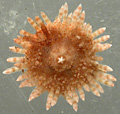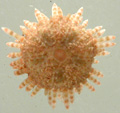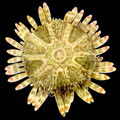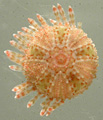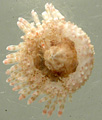The Echinoid Directory
Contributed by Heinke Schultz, August 2007
Arbaciella Mortensen, 1910, p. 327
| Diagnostic Features |
|
|---|---|
| Distribution | Recent, West Africa, Mediterranean. ?Danian Europe, Kazachstan |
| Name gender | feminine |
| Type | Arbaciella elegans Mortensen, 1910 p. 328, by original designation. |
| Species Included |
|
| Classification and/or Status | Euechinoidea, Echinacea, Arbacioida, Arbaciidae Monotypic. |
| Remarks | Mortensen (1910) stated, that this species looks very similar to young specimens of Arbacia lixula. But it differs by the total lack of aboral spines. He considered that Arbaciella might be a paedomorph of Arbacia. Last doupts on the validity of the genus were eliminated by the work on the microstructure of Arbaciella by Regis (1982). Arbaciella elegans was reported to live in the Mediterranean on the valves of Pinna, a bivalve, (Giacobbe & Rinelli, 1992). Recently it was found in the crevices of Lithotamnion, an incrusting Red Algae (Baumeister & Koch 1998). This species bears a striking resemblance to Podocidaris ornata (H.L. Clark 1912). It remains to be seen how these two taxa differ. Mortensen, T. 1910. Arbaciella elegans. Eine neue Echiniden-Gattung aus der Familie Arbaciidae. Mitteilungen des Naturhistorischen Museum Hamburg, 27: 327-334. Regis, M.B. 1982. Donnes microstructurales et validite du genre Arbaciella Mrtsn (Echinodermata-Echinoidea). Memoires sur le Biologie Marine et Oceanographique 12: 5-26. Giacobbe, S. & Rinelli, P. 1992. Ecological notes on Arbaciella elegans Mortensen from populations of Pinna in the Strait of Messina. In: Scalera-Liaci, L & Canicatti, C. (eds) Echinoderm Research 1991: 185-189; Rotterdam, Balkema. Baumeister, J.G. & I. Koch 1998. Arbaciella elegans (Echinoidea: Arbaciidae) aus dem Thyrrenischen Meer. Stuttgarter Beitrage zur Naturkunde. Serie A (Biologie) 568: 1-6. Stuttgart |
